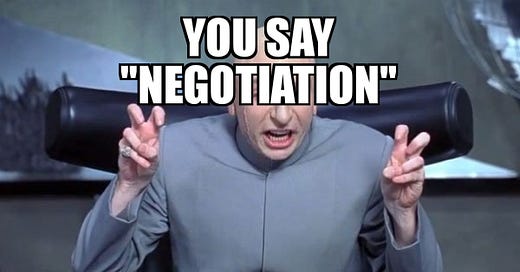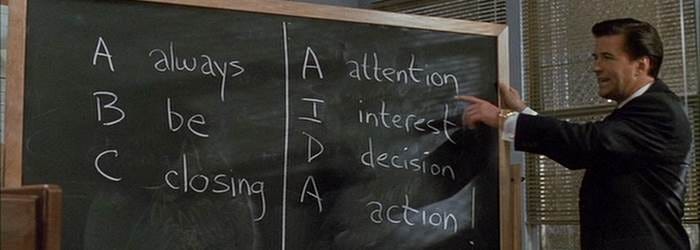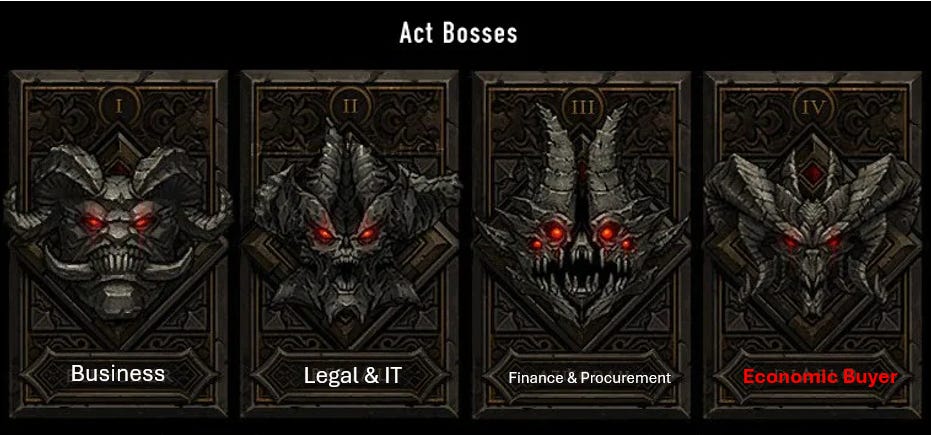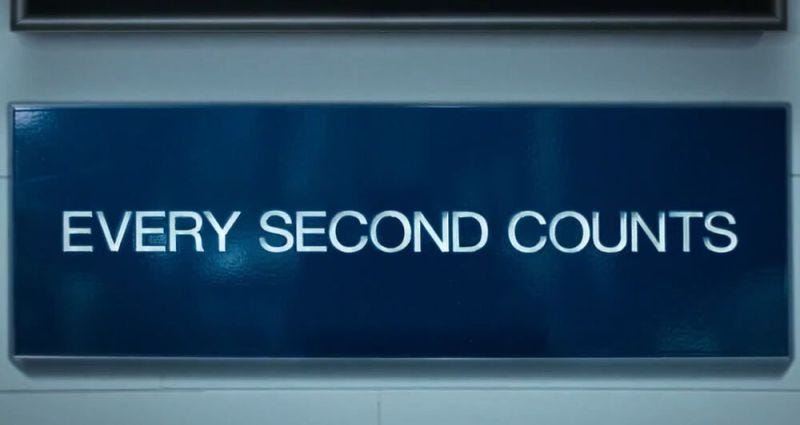Ever found yourself in a situation where you know somebody is interested but just can’t seem to get them to pull the trigger?
You probably have but let me tell you, I have no idea how it feels to struggle closing deals. I get the yes every. single. time.
I do this because I know how to close, and you could too if you got off Tik Tok for 2 minutes to read this article!
Hey! Put the Zyn down, Zyn is for closers!
Okay, that was my Blake impersonation (Alec Baldwin from Glengarry Glen Ross). If you haven’t seen the movie, Blake is brought in to motivate a group of underperforming salespeople with a rousing speech about how they could earn millions, if only they knew how to close.
“A-B-C. A-always, B-be, C-closing. Always be closing! Always be closing!!”
While yelling expletives at people might have worked in the nineties, these are different times. Plus, my throat is kind of sore, so I’m opting for a softer approach.
If you read my previous article “How to Not Suck at Sales”, you will know how to get somebody to want to buy your product. Getting people to want what you are selling is a great skill to master, but is insufficient on its own.
Knowing how to close a prospect is what keeps businesses alive, helps you land that job offer and convinces that person to go on that date with you. This is ultimately what matters.
Building off Part I, this article will teach you the tactics to get that all-important 'yes,' especially when dealing with finance, IT, legal, and procurement departments.
Master Parts I & II and I am certain you will Always Be Closing.
Disclaimer: This is not an article about how to negotiate .If you want to read about negotiating strategies, here is a great one from Polina Pompliano. This article you are about to read is a tactical guide to steps you will encounter in a B2B sales setting if you want to get a deal closed. You can also help this serve as a guide to other complex sales situations you find yourself in.
By the end of the last article, you learned why people buy, the importance of building a high-quality pipeline, why you need to find pain to make a sale, the importance of demonstrating how you solve this pain, and finding a champion to help make the deal happen. Assuming you have identified a champion with influence, let’s outline how you will actually get the deal closed.
You’ve done a lot of great work winning over your champion and the relevant business function (The Business). Now, they are working for you, pushing to get the rest of their company on board. The bigger your prospect, the more hurdles your champion will encounter. When you are selling directly to consumers, you only need to win over one person, the end buyer (unless their partner or parents decide their budget). In a B2B setting, many departments need to approve any new purchases.
The finance team will set the company budget and control company spending; they need to confirm there are available funds.
IT is responsible for the different technology the company uses; they need to determine if introducing a new product would introduce vulnerabilities to their systems or upend any existing business processes.
The procurement function ensures that the purchasing department follows the company’s processes and feels comfortable with the business terms and conditions.
On top of that, the legal team needs to accept the general legal terms and conditions associated with the use of the product.
If you manage to satisfy all of these department conditions, you still need to get past the Economic Buyer (EB). The Economic Buyer is the person with ultimate control of the funds. Depending on the purchase size, this could be a VP of Finance, Controller, CFO, or an executive with discretionary use of funds.
In the context of a video game, think of the Economic Buyer as the final boss you need to slay to win the game, with procurement and all these other departments serving as the minions that try to weaken you and slow you down before you get to the showdown battle (please don’t try to kill any employees of your prospects' companies, no matter how annoying conversations with IT, Legal, or Procurement can get).
The order in which these bosses will appear can vary, but you will need to defeat all of them if you hope to close the deal. If you are not engaged with any of the stakeholders in IT, Procurement, or Legal, you are not close to winning. Since the Zero-Interest Rate Party (ZIRP) ended, companies are scrutinizing budgets like never before. Purchases that used to get waived through in a couple of weeks can now spend months or quarters in one of these steps. Selling during ZIRP was like playing the video game Diablo on normal mode; these days, you are playing through Hell.
Do not let that discourage you. You can still close deals, but it will take longer, and you will need to ensure you are solid with your execution. Before I explain what you need to achieve with each department, here are a few maxims to remember when looking to close a deal. These apply for all of these stakeholders.
Maxim #1 Slow down to go fast:
Don’t skip steps, nothing derails a deal more than a new stakeholder emerging late in the process. They will be annoyed they were not previously consulted and will delay things as they get up to speed. The motivation makes sense, you want to try to get to the Economic Buyer as quickly as possible and avoid potential roadblocks. Sometimes, your champion will even encourage this approach. This would be a mistake. These days, nothing is getting bought without all of these stakeholders weighing in; like it or not, they will at some point be consulted. Trying to cut them out of the process will only give you a false sense of confidence and start the relationship off on a sour note when you do encounter these stakeholders. It is good to understand what price thresholds trigger what reviews. If you are close to a limit, you might consider re-pricing in such a way to avoid to be subject to the lower level of review1.
Maxim #2 Make sure your champion knows their buying process:
You would be surprised how often you are working with a champion that does not know the steps involved in getting a deal closed. Your champion can be new in their role or this could be their first purchase with the company, or the first time at the dollar amount. Don’t assume they know what is involved. I have seen many deals get derailed because a champion committed to a signing date within a few weeks not knowing their company’s average IT review takes 3 months. Ensure that you outline all the steps that need to be accomplished before you can get to the economic buyer and seek approval. Regularly confirm that all the steps have been cleared, no new stakeholders or steps have been added or else you are in for bad surprises.
Maxim #3 Cast as wide a web as possible:
Having a champion trying to help you win is good. You know what is even better? Many people in your prospects organization trying to help you win. Deals cannot advance without the approval of IT, Finance, Legal and Procurement, instead of fighting with each department individually, what if you got some of them to fight with you? Some departments will have more influence than others, by building champions in these other departments, they could apply pressure on other departments to move faster or be more lenient with their demands. If IT loves your product, they can help you argue with legal to loosen up on some of their demands. If you’ve offered a compelling discount, finance or procurement might apply pressure on legal to move faster (more on that later). Build more allies.
Maxim #4 Time Kills Deals
Move quickly. The longer time passes, the more room for new variables: changing personnel, new processes, emerging competitors, bad economic news, weak financial results, bad vendor experiences. The more time passes, the higher the likelihood of these issues arising. Push the pace to avoid these barriers.
Does this contradict “Slow Down to Go Fast”? Not at all. Move quickly through the process, ensuring no steps are skipped to avoid future issues. Always email your prospect the same day, summarizing discussions and next steps. Never finish a meeting without scheduling the next one, taking the earliest available date. Every second counts. Most salespeople miss this, interpreting moving fast as setting aggressive timelines or offering discounts for quick signatures. If you don’t understand what needs to be done and provide a reasonable time frame, you’re making a useless offer and simply showing you can go lower, which leads to the next maxim.
Maxim #5 Don’t make ideal threats
If you make a conditional offer, your prospect needs to stick with your conditions. Procurement people go through hundreds if not thousands of purchases in their career. They understand they have the leverage and won’t be fooled by your posturing. Once you show a prospect that they can miss a deadline, they will keep this in their back pocket. If you show them the ability to discount if signed by a certain date, they will just see this as you have the ability to discount (See this footnote for a personal story on this2). Unless you provide a clear captivating reason why they can only benefit from a discount by a certain date and why it will disappear if it is signed one day later, they will simply anchor themselves on the new price.
Maxim #6: Every call is a sales call & add value on each exchange
A sale is made on each call. Either you’ve sold them on buying your product, or they’ve sold you on why they can’t or won’t. You might meet with a prospect dozens of times and exchange 100 emails before closing. With each exchange, move closer to your goal. Have a game plan for what to convey, discover, and accomplish, and know the next step for the following meeting. The same applies to emails, even follow-ups. Always add value. Which is more likely to get movement from your prospect “Hi, Karen, have you heard back from legal yet?” or “Hi Karen, we have an update from your question related to IT—we can accept change X or Y. This positions us to hit our target signing date. The only thing we foresee standing in the way is with the contract, have you heard back from legal yet?”
Too often, salespeople attend meetings unprepared, without clear agendas and desired outcomes. Meetings that end with no clear call to action or next step mean you’re not selling. Closing a deal is like pushing a boulder up a hill; every day you’re not pushing it closer to the top, it’s rolling back down.
Ben Affleck gets it!
Skip to 1:52 for this pressed for time. The film is Boiler Room (1998)
With these 6 Maxim’s in mind, now we will learn what each department is hoping to achieve, to successfully navigate potential roadblocks and ultimately create broader alignment. If you are unsuccessful in getting these stakeholders on your side, they will disrupt your deal and you will not be able to close.
If you could see one week into the future and knew your house was going to catch fire, how quickly would you buy higher fire insurance coverage? It would become a top priority. As a good salesperson, you need to create that same urgency in your prospect.
For some products, this is easy. If a routine medical operation is needed to stay alive, you wouldn’t conduct a 12-month Request For Proposal (RFP). You’d find the first competent, available doctor and do only light due diligence before agreeing to the procedure. If anyone stood in your way (insurance companies, hospital staff, etc.), you’d be banging down their doors to get approval.
Prospects rarely see purchasing your product as a life-or-death matter, so you need to create this urgency. Not only does your champion need to believe this, but all stakeholders must too. The better you convince them that buying your product is critical for the business, the more control you’ll have in your deals, and the more likely you are to win. Each stakeholder needs a different approach.
The Business:
We touched on this in part I but the users of your product need to believe that whatever you are selling them will help them reach their department level goals. If you are selling to the sales department, they need to believe that this will somehow help them sell more. If you are selling to HR, they need to believe they will be able to better manage the company workforce. If you cannot even successfully convince the business about the urgency of solving their pain by buying your solution, you don’t even need to worry about the other stakeholders (see As-Is and To-Be from Part I).
Legal:
Every large company has a lawyer reviewing every contract, whether in-house or through a law firm on retainer. If you want them to sign something, legal needs to approve it first. Unless the purchase concerns the legal department directly, they rarely care about the business case or problems solved, focusing only on potential risks the company faces by entering the agreement. Left to their own devices, the legal team will work at their own pace, preferring to triple-check everything rather than rush to help you close the deal. In-house legal teams are usually lean relative to the requests they receive, so they have many competing priorities. If your champion does not apply pressure on legal, your document could wait in a heap with other requests for months. The legal team needs to be convinced that reviewing your documents is a company priority. You will not always have direct access to the legal team, so you need to rely on your champion to apply this pressure. It also helps to get buy-in from other high-level executives who can support your champion in applying pressure.
To expedite the process with legal, it can be helpful to ask your prospect for their standard template and have your team review and differences in terms with your own. This way your legal team can offset their workload, immediately trying to resolve any conflicts. Most conflicts between customers and vendors are rarely legal matters. Commonly these are more business decisions such as the right to auto-renew or the right to terminate the agreement at any moment. You do not need to be Mike Ross from Suits to understand if these are changes you can accept.
IT:
IT teams deal with hundreds or thousands of software vendors across various departments. Vendors can also sell multiple products to different departments, with varying contract dates, requirements, jurisdictions, and regulations. The IT team must ensure that none of these software licenses conflict with company-wide policies and regulations, while also demonstrating their value to the business.
IT is weary of adding new vendors; a common rebuttal software vendors hear is, “Why don’t we simply build this in-house?” It’s a fair question, but few companies have the talent and focus to successfully build and deploy complex solutions internally. Your response could be, “Do you have a team of 20-50 idle engineers who can dedicate the next 2-3 years to building this? If so, it would cost much more than a $100K annual license plus implementation we are charging you.” What they really want to know is if your software fulfills a need that can’t fulfilled existing solutions or Microsoft Office.
IT prefers sticking with existing vendors to simplify their operations. They will often ask, “Can this be fulfilled by an existing vendor?” This is tricky, as incumbent vendors try to expand their presence and block others from entering. This sparks the best-of-breed vs. best of suite debate: Is it better to get the best solution from multiple vendors or rely on one vendor with many solutions?
I spent a summer at SAP in their value advisory group3, part of my job was to build presentations arguing either side of this debate, depending on whether we were the incumbent or trying to enter an account. The truth is, you can find evidence pointing to either approach being more cost effective but these days IT teams seem to be pushing to consolidate vendors making it difficult if you are not already an incumbent. If you are a best-of-breed vendor, offset this disadvantage by engaging with IT early, convince them your solution requires minimal time commitment, and highlight that you might be easier to work with compared to big vendors, which are often more rigid.
Finance:
I can do a full post on how finance decides to allocate capital but put simply, the goal of the finance department is to ensure that money is well spent. They judge this on a key parameter: ROI. Return On Investment. What are the financial implications of purchasing your product/solution in the future. There are two inputs to this:
1) Initial and recurring cash outflow (the investment): the cost you are charging them
2) Future cash inflow (the return): future incremental revenue or cost savings from using your product
The cost side includes more than the amount you quote them, you need to factor in the opportunity cost. By allocating funds to your product, they can’t spend that money elsewhere. At a minimum that money can sit in their bank account or in short term bonds earning 5% interest. Not only are you competing against bank interest, there are countless other projects that stakeholders at the company want funded, therefore finance needs to believe this is the best place to put that money. This is judged along by the return piece of the equation.
The return needs to increase revenues, reduce expenses or reduce risk. The first two are generally easier to quantify, if they are in excess of the cost, it has a positive ROI. The finance team will determine what their target ROI percentage is (called the hurdle rate4), if they believe your project clears the necessary hurdle rate by a sufficient margin, they will compare your purchase with other possible projects. When presenting your business case to finance, make sure it can tie back to measurable impact to the company’s revenues or profits. If your whole pitch is around nicer dashboards or better UX, finance is not going to be on your side.
If your project rates favorably and you have a strong champion, there is a decent chance that finance will approve it. At times there are company wide budget cuts or freezes which can present serious challenges but if you can successfully convince the business, finance and all of these stakeholders that this is something that must be purchased now and finance has confidence in the ROI, finance will pass you on to the final boss, the economic buyer…unless
Procurement:
Procurement professionals ensure that purchases follow company policies. Sometimes they act as facilitators; other times, they are the biggest blockers. They might prevent direct contact with stakeholders, making it difficult to create alignment and champions in different departments. Every message is filtered through them, which can be both good and bad. Companies often limit a vendor’s direct dealings with stakeholders, complicating the salesperson's control over the process.
When dealing with an adversarial procurement team, they will largely keep you in the dark and cast fear, uncertainty and doubt (FUD), effectively gaslighting you so you believe you are less likely to win your deal. They do this to extract price or legal concessions from you and other potential vendors. Procurement professionals will often have OKRs around cost savings or adding flexibility to their contracts, such as the dreaded termination for convenience5.
The best way to get through procurement is by leveraging a strong champion and forcing the procurement team to choose between cost savings and flexibility. This positions you to raise the price or push for a longer-term deal. Make any offer conditional on closing by a certain date to compel procurement to act or reveal your standing in the process. Then, follow maxim #5 and adhere to deadlines. The party most willing to walk away from the negotiating table has the leverage; generally, this is the buyer. Convince procurement that you are prepared to walk away if the deal is not acceptable to you and your organization.
If you get through procurement and the other stakeholders, you'll eventually face the Economic Buyer (EB) to close the deal.
The EB is the final hurdle, typically a high-ranking executive or finance team member with the final say. A strong champion can get you in front of the EB; otherwise, you must equip them to handle the EB’s objections alone. The EB is the last line of defense for a company about to spend money.
It’s crucial to address potential objections with other stakeholders before reaching the EB. If the EB raises questions and feels the purchase has too many uncertainties, they will force the champion to go back and gather more information. If you’ve addressed previous stakeholder questions well, dealing with the EB becomes easier. When a deal gets less scrutiny, the showdown with the EB becomes more critical. The EB is accountable for their department’s financial performance and will avoid approving anything that might reflect poorly on them. Ensure they are confident in the business case and agree with your champion that this is a good use of resources.
By mastering this process, you can close many deals without relying on desperate or aggressive sales tactics. To recap, today we learned what it takes to turn a qualified prospect into a closed deal. We discussed the importance of slowing down to go fast, ensuring your champion knows their buying process, casting a wide net, why time kills deals, why you can’t make idle threats, and why every interaction is a sales interaction. We covered what each stakeholder aims to achieve and what you need to do to win them over. With this knowledge, you should be able to control your deals and become a closer.
In many large companies these normally happen at purchase sizes of $50K, $100K, $500K, $1M but this is something to validate with your champion.
A prospect I was dealing with had reached out to us very interested in buying my company’s product. They were recently bought by a Private Equity (PE) firm and had a very lean corporate structure. The PE firm appointed a corporate fixer to run finance in the interim. Entering the call, I felt confident as I had done many negotiations with procurement or high level finance people and often came out with a favorable result. My role was to ensure this deal closed within the quarter and to negotiate concessions related to finance or legal terms. I was not prepared for what turned into a hostage negotiation.
Our first meeting was very pleasant meeting, all the right buying signals were there and it looked like this would easily close before the end of the quarter. He committed to being able to wrap things up quickly but asked for a slight gesture in exchange for signatures before the end of the month. We had agreed to give a slight reduction from the quote we had originally provided and we had our next meeting scheduled two weeks later.
During this subsequent call, he then demanded to know how the price was able to come down so much after the first quote and why we came forward with the initial offer and how much more are we still screwing them? Of course when I called out directly what he was doing, he began to gaslight and claim he was simply trying to discover more about us, and this was a partnership etc. This guy was a seasoned pro. Luckily for us we had given ourselves a decent amount of wiggle room with the original quote so it was still an okay deal for us but he definitely caught me, the AE and VP of sales off-guard. He ended up getting hit by a car 3 weeks before the end of the quarter and the deal slipped into the next quarter (true story). This is why time literally kills deals.
Team of in-house consultants that built business cases for customers that strangely always led to the conclusion that they should buy more from SAP
The hurdle rate changes depending on the project. The less certain they are in the outcome, the higher the hurdle rate. The higher the cost of these funds, the higher the hurdle rate. If the cash needed for the project is sufficiently high forcing the company to raise debt to afford your project, the internal cost of the project is higher than using idle cash on hand. This is why they will use a different hurdle rate for a small product purchase compared to acquiring a company. Both are uses of cash but the sources of this cash differ.
This allows a customer to end an agreement at any moment without any reason needed. This gives vendors nightmares and investors hate this. As a Salesperson you might not care but if your company has any semblance of smart compensation, you will earn lower commission on deals where this clause is present. Don’t offer discounts to prospects who insist on this.













Ben: these are two of the best articles on sales I’ve ever read. Two points I loved:
1. Summarize each meeting that day with follow up points.
2. Set the next meeting during the current one.
So simple, yet keeps the deal momentum alive.
The Bosses - so true!
Who's the worst?